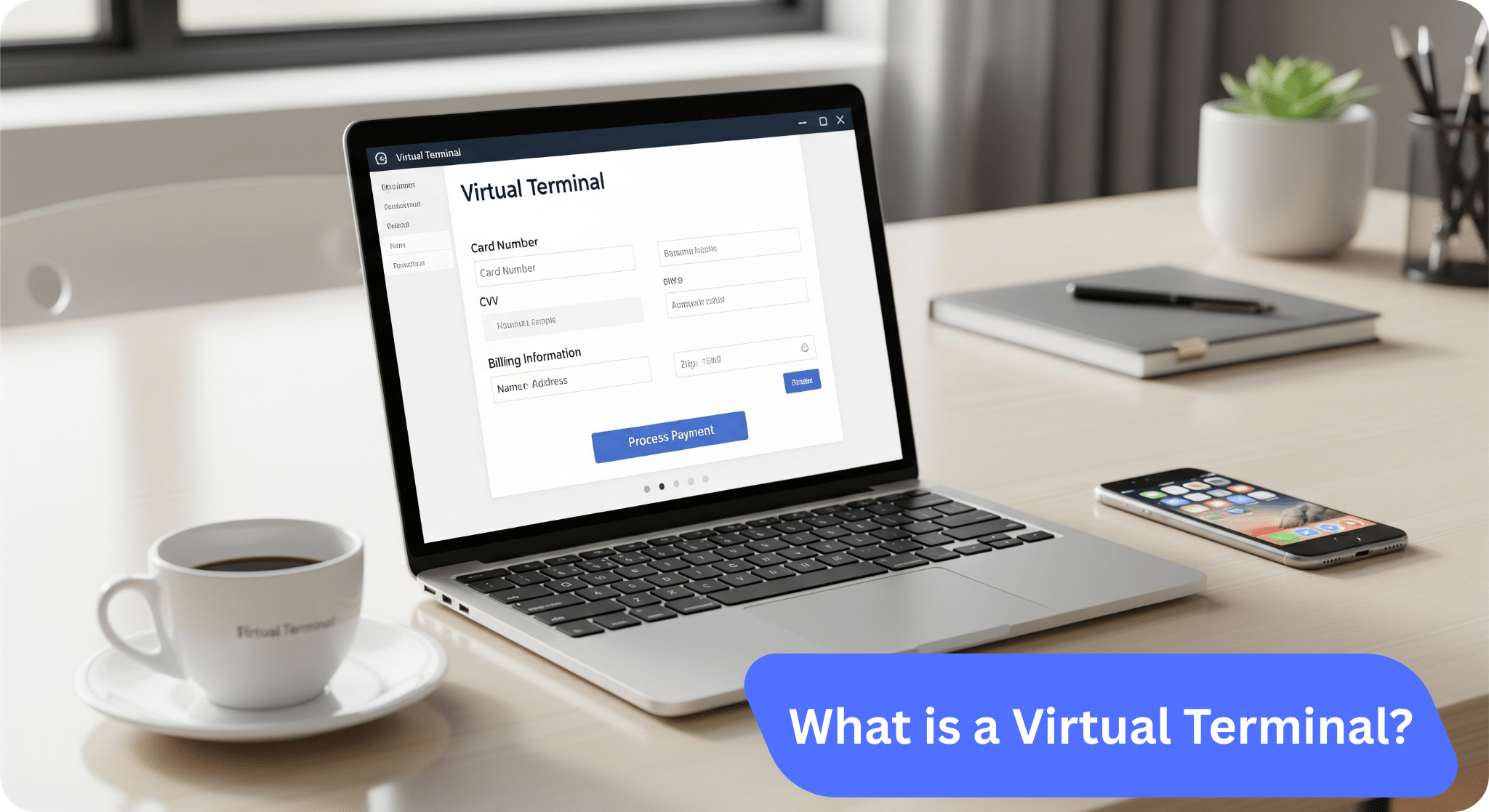Table of Contents
- What Is a Virtual Terminal?
- How a Virtual Terminal Works
- Benefits
- Best Use Cases
- Key Features to Look For (2025)
- Security, Compliance, and Costs
- Virtual Terminal vs. Full POS
- How to Choose the Right Solution
- How Biyo POS Helps
- FAQ
What Is a Virtual Terminal?
A virtual terminal is a browser-based payment screen that lets you manually key in a customer’s payment details and process card-not-present transactions without a physical card reader. It’s like having a “payment terminal in the cloud,” accessible on any device with an internet connection.
Typical scenarios include phone orders, email invoices settled by phone, mail order/telephone order (MOTO), and back-office billing for professional services.
How a Virtual Terminal Works
1) Access
Log in from a desktop, laptop, tablet, or phone. No special hardware required.
2) Input
Enter card number, expiry, security code, billing address, and the amount to charge.
3) Authorization
The terminal securely sends the data to the processor for authorization and returns an approval/decline within seconds.
4) Receipts and Settlement
Email or print a receipt. Approved transactions are batched and settled to your bank account per your funding schedule.
Benefits
Fast Setup
Start taking payments quickly—great for new teams, pop-ups, or remote staff.
Flexibility
Use any modern browser; no reader or POS hardware is strictly necessary.
Operational Reach
Accept payments when the cardholder isn’t present: phone orders, invoices, bookings, deposits, and retainers.
Best Use Cases
- Restaurants and cafés taking phone orders or deposits for catering.
- Service businesses (repair, consulting, healthcare, legal) billing by phone.
- Multi-location operators that need a centralized way to collect payments.
- Seasonal or mobile vendors that don’t always carry card readers.
Key Features to Look For (2025)
Integrated Customer Profiles
Store customer info, notes, and payment preferences for faster repeat charges (within compliance rules).
Saved Cards and Recurring Billing
Tokenize cards for memberships, subscriptions, or installment plans.
Invoices and Quick Pay Links
Create invoices and share secure payment links to reduce phone time and input errors.
Multi-Tender and ACH
Support credit/debit cards, digital wallets (where available), and bank transfers.
Omnichannel Sync
Unify web, in-store, and phone orders into one dashboard for inventory, reporting, and analytics.
User Roles and Approvals
Restrict who can view, issue refunds, or run high-value transactions.
Reporting and Reconciliation
Export settlements, fees, and payouts to your accounting system.
Security, Compliance, and Costs
Card-Not-Present Risk
Manually keyed transactions carry higher fraud risk than card-present; expect slightly higher processing rates.
Controls That Help
- Address Verification (AVS) and CVV checks
- 3D Secure (where applicable)
- Velocity limits, spending thresholds, and manager overrides
- Audit logs for who did what and when
PCI Considerations
Use a provider that keeps card data out of your environment with tokenization and secure iFrames; train staff on safe handling of card data.
Virtual Terminal vs. Full POS
A virtual terminal is perfect for quick, keyed transactions. A full POS adds inventory, menus, modifiers, staff time tracking, kitchen display systems (KDS), and in-person payments. Many businesses use both.
| Capability | Virtual Terminal | Full POS |
|---|---|---|
| Hardware Needed | None (browser only) | POS tablet/terminal, optional peripherals |
| Use Case | Phone/MOTO, back office, deposits | Walk-in counter service, table service |
| Inventory & Menus | Basic or none | Full item/recipe/menu management |
| Fraud Exposure | Higher (card-not-present) | Lower (card-present with EMV) |
| Staff Tools | Light (roles, logs) | Scheduling, timecards, KDS, loyalty |
How to Choose the Right Solution
Match to Your Workflow
Phone-heavy? Prioritize speed of manual entry, saved cards, and AVS. Counter-heavy? Make sure your POS and terminal share customers, items, and reporting.
Look at Total Cost
Compare keyed vs. card-present rates, monthly fees, chargeback costs, and payout timings.
Check Integrations
Ensure smooth sync with your POS, accounting, CRM, delivery apps, and inventory.
How Biyo POS Helps
Virtual Terminal + POS, Unified
Biyo POS combines an easy virtual terminal for phone and back-office payments with full POS features for in-person sales. Keep menus, customers, and reporting in one place.
Saved Cards, Invoices, and Links
Securely store cards (tokenized), send invoices, or share quick pay links to speed up collections and reduce manual keying.
Controls and Visibility
Role-based permissions, approvals for high-value charges, detailed logs, and real-time reporting across locations.
Want a demo? Contact Biyo POS to enable Virtual Terminal and start taking payments today.
FAQ
Is a virtual terminal PCI compliant?
Yes—when provided by a compliant processor and used correctly. Make sure card data stays within the provider’s secure forms and train staff on safe handling.
Are fees higher than swiped/tapped payments?
Usually slightly higher due to card-not-present risk. Minimize fraud with AVS, CVV, and (where available) 3D Secure.
Can I accept ACH or bank transfers?
Many virtual terminals support ACH; settlement times and return windows differ from cards.
Does it work with my POS?
Choose a solution that syncs customers, catalog, and reports so your keyed and in-person sales live in one system.

